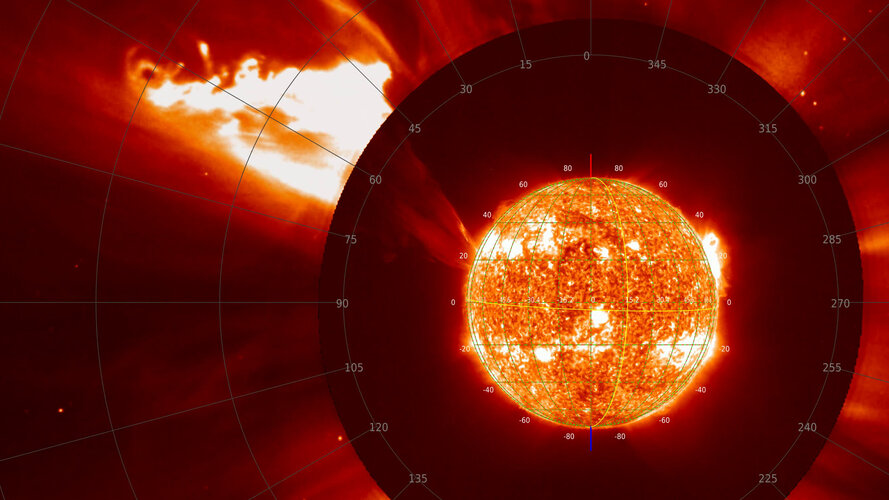
Copernical Team
Earth from Space: Tenerife, Canary Islands

The Copernicus Sentinel-2 mission takes us over Tenerife – the largest of Spain’s Canary Islands.
100 days of Cosmic Kiss
 Video:
00:04:40
Video:
00:04:40
English - 100 days of Cosmic Kis
On 11 November 2021, ESA astronaut Matthias Maurer was launched to the International Space Station for his first mission, Cosmic Kiss. Around 100 days later, we reflect on some highlights from space.
Matthias flew to the Station on a SpaceX Crew Dragon alongside NASA astronauts and fellow first-time fliers Kayla Barron and Raja Chari, and NASA spaceflight veteran Tom Marshburn. Collectively known as Crew-3, they were welcomed as members of Expedition 66 by Commander Anton Shkaplerov, cosmonaut Pyotr Dubrov and NASA’s Mark Vande Hei.
While in orbit, Matthias is supporting over 35 European
Giant solar eruption seen by Solar Orbiter

The ESA/NASA Solar Orbiter spacecraft has captured the largest solar prominence eruption ever observed in a single image together with the full solar disc.
NASA challenges students to discover what powers them
 NASA is inviting students to participate in an essay contest to explore how it powers some of its most famous missions. The contest also encourages participants to learn something about themselves in the process. The Power to Explore Challenge, open to K-12 students in U.S. public, private, and homeschools, is accepting entries from Tuesday, Feb. 15 through Wednesday, April 13.
The competi
NASA is inviting students to participate in an essay contest to explore how it powers some of its most famous missions. The contest also encourages participants to learn something about themselves in the process. The Power to Explore Challenge, open to K-12 students in U.S. public, private, and homeschools, is accepting entries from Tuesday, Feb. 15 through Wednesday, April 13.
The competi Latecoere strengthens its space activities through three cooperations with Airbus
 Latecoere, a leading partner of major international aircraft manufacturers and the European leader in satellite wiring, is strengthening its activity in the space industry thanks to three major cooperation projects with Airbus.
Latecoere designs, industrializes, produces and integrates electrical harnesses for three emblematic European space programs: the Eurostar Neo satellites, for both
Latecoere, a leading partner of major international aircraft manufacturers and the European leader in satellite wiring, is strengthening its activity in the space industry thanks to three major cooperation projects with Airbus.
Latecoere designs, industrializes, produces and integrates electrical harnesses for three emblematic European space programs: the Eurostar Neo satellites, for both Can a planet have a mind of its own?
 The collective activity of life-all of the microbes, plants, and animals-have changed planet Earth.
Take, for example, plants: plants 'invented' a way of undergoing photosynthesis to enhance their own survival, but in so doing, released oxygen that changed the entire function of our planet. This is just one example of individual lifeforms performing their own tasks, but collectively having
The collective activity of life-all of the microbes, plants, and animals-have changed planet Earth.
Take, for example, plants: plants 'invented' a way of undergoing photosynthesis to enhance their own survival, but in so doing, released oxygen that changed the entire function of our planet. This is just one example of individual lifeforms performing their own tasks, but collectively having Students with Perseverance receive messages from Mars
 The first set of middle-schoolers in the agency's "You've Got Perseverance!" campaign was honored with a message from the Red Planet and a chat with the rover team at JPL.
A group of 20 young students who have shown the character trait that NASA's Perseverance rover is named for received messages of encouragement directly from that six-wheeled scientist on Mars.
Nominated by educator
The first set of middle-schoolers in the agency's "You've Got Perseverance!" campaign was honored with a message from the Red Planet and a chat with the rover team at JPL.
A group of 20 young students who have shown the character trait that NASA's Perseverance rover is named for received messages of encouragement directly from that six-wheeled scientist on Mars.
Nominated by educator Secondary cratering on Earth: The Wyoming impact crater field
 Several dozen small impact craters, 10-70-m in size, have been discovered in southeastern Wyoming. A team of U.S. and German geoscientists found these ancient craters in exposed sedimentary layers from the Permian period (280 million years ago).
After discovering the first craters, the team initially suspected that they are a crater-strewn field, formed by the breakup of an asteroid that e
Several dozen small impact craters, 10-70-m in size, have been discovered in southeastern Wyoming. A team of U.S. and German geoscientists found these ancient craters in exposed sedimentary layers from the Permian period (280 million years ago).
After discovering the first craters, the team initially suspected that they are a crater-strewn field, formed by the breakup of an asteroid that e Space sector set to create new jobs in Highland and Moray
 Ambitious plans to create hundreds of high quality jobs and business opportunities by developing a North Highland and Moray 'space cluster' have received a 38,000 pound boost from the UK Space Agency.
A strategy to develop the cluster, funded by Highlands and Islands Enterprise (HIE) and Dounreay Site Restoration Ltd (DSRL), was published last September by Caithness and North Sutherland
Ambitious plans to create hundreds of high quality jobs and business opportunities by developing a North Highland and Moray 'space cluster' have received a 38,000 pound boost from the UK Space Agency.
A strategy to develop the cluster, funded by Highlands and Islands Enterprise (HIE) and Dounreay Site Restoration Ltd (DSRL), was published last September by Caithness and North Sutherland Preventing Lunar traffic jams
 The moon is top of mind for many national space programs and private companies, with some planning to send humans back to the lunar surface as early as 2025.
In advance, scientists are launching satellites and other payloads to orbit the moon. But so far, no one has kept track of just how many artificial objects are already up there, or where they are at any given moment. Without a way to
The moon is top of mind for many national space programs and private companies, with some planning to send humans back to the lunar surface as early as 2025.
In advance, scientists are launching satellites and other payloads to orbit the moon. But so far, no one has kept track of just how many artificial objects are already up there, or where they are at any given moment. Without a way to 
































